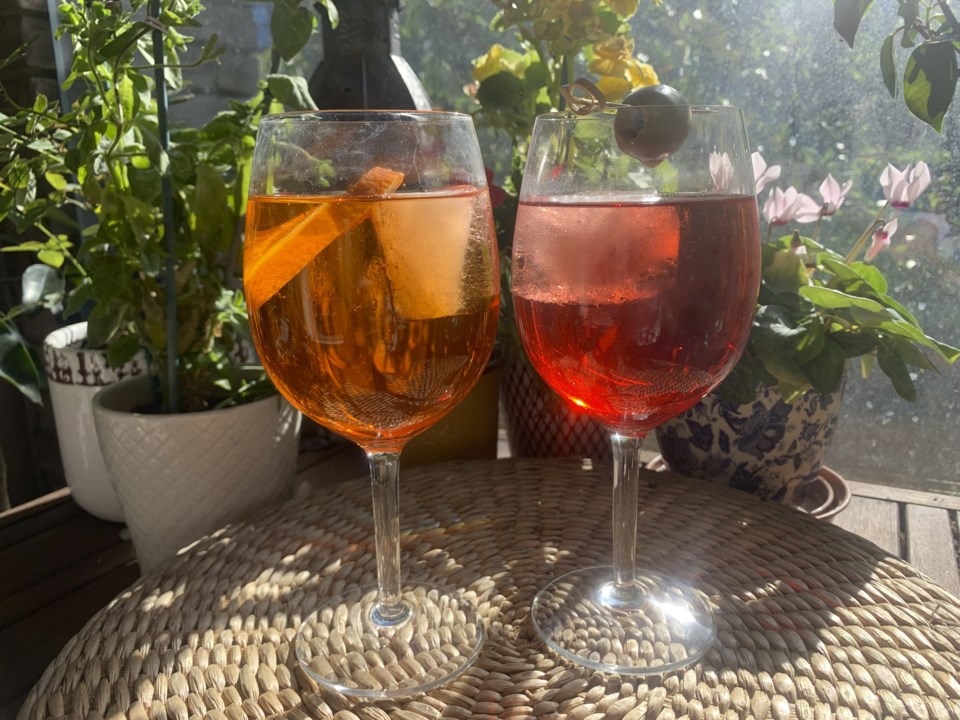VENICE, Italy (AP) — A glowing sea of bright orange and red cocktails has become a common sight in bars and restaurants across Europe and beyond as the Italian-born spritz continues to find new fans.
This wine-based cocktail was served as an aperitif in northeast Italy for decades, and drunk with cicchetti (Venetian tapas) across the neighborhood bars of Venice. The modern spritz consists of prosecco, digestive bitters and soda water.
It originates in the mid-19th century, in the time of the Austro-Hungarian Empire. It's believed that some Austrians found Italian wines too heavy, so would ask the bartender for a “spritzen” (splash) of soda water to dilute them. That became the first spritz recipe.
The bitters came later. Sweeter-tasting orange Aperol was created in 1919 in Padua, Italy. The deep-red bitter digestif Select followed in 1920, from the Castello district of Venice. These liquors were made with a combination of botanicals.
Italian aperitif Campari has long been a popular ingredient in the Negroni cocktail but is also growing in popularity as a spritz.
Rudi Carraro, brand ambassador for Select, explains that Venice was at the heart of the Italian spice trade, so “it was easy for them to source spices and herbs and botanicals from all around the world, to create their perfect recipe that still today hasn’t been changed.”
Describing Select’s flavor, Carraro says, “at the beginning, you have these very nice, aromatic, citrusy notes that come from oranges and a hint of cardamom.” Added to this is rhubarb rhizome which he says gives a “grassy, deep-flavored, earthy” taste that “keeps on coming back.” Finally, you have artemisia, commonly known as wormwood, which "makes the finish long and bitter on the back of your throat.”
Originally, aperitifs were drunk on their own, “maybe with a bit of ice or soda, to get a bit of length,” Carraro says. It wasn’t until the '50s that these Italian liquors were used as a cocktail ingredient and added to the spritz, although “just a splash at the beginning.”
In the '70s, prosecco frequently replaced the white wine, making the modern spritz more bubbly and appealing to a younger generation, says Carraro.
But it wasn’t until the 2000s that the spritz moved from Venetian aperitif to worldwide phenomenon.
Sales of spirit aperitifs grew in volume globally by 26% in 2021 over the previous year, according to IWSR Drinks Market Analysis. The top five markets for aperitifs are Italy, France, Germany, Brazil and Argentina. Over the past five years, global aperitif volume has grown steadily, with Italy, France, Germany, Brazil and Argentina the top five markets.
The spritz is a factor in that rise. Linda Passarella, director of global aperitifs at Campari Group, which also owns Aperol, says the spritz is light in alcohol “in line with the emerging trend" of lower-alcohol drinks.
Consumer tastes are also changing; while Italians are used to bitter flavors at a young age, the rest of the world now knows more about Italian aperitifs and is experimenting more with those flavors.
“We start to drink coffee at grandma’s house when we are very young” says Italian-born Carraro, adding that even the non-alcoholic beverages that Italian kids drink are bitter.
Luca Boso, manager of the Terrazza Aperol bar in Venice, says Aperol tastes like gentian herb, vanilla, florals, “plus a lot of orange.”
Aperol's biggest growth is still in Europe, but Passarella says her group is looking to expand in the U.S. and also Asia.
She sees the Aperol spritz as the entry point into the aperitif journey. “It’s a well-balanced, bittersweet kind of taste profile, so it is very approachable in terms of taste,” she says.
“When consumers would like to have a more refined experience, more bitter taste, then they try Campari spritz. Campari spritz is more sophisticated, offering a more complex taste profile.”
Whichever bitters you chose, the modern recipe is simple: 3 parts prosecco, 2 parts bitters, a splash of soda and plenty of ice, finished with an olive or a slice of orange.
Carraro encourages experimentation.
“What I love about the spritz recipe is that it’s really up to you, as you like it," he says. "I like mine with a little bit more Select in there because it makes it a little more bitter. If you want to have more soda to make it lighter or more ice, less ice, it’s totally up to you.”
—-
For more Food and Drink stories from the AP, go to .
Louise Dixon, The Associated Press



